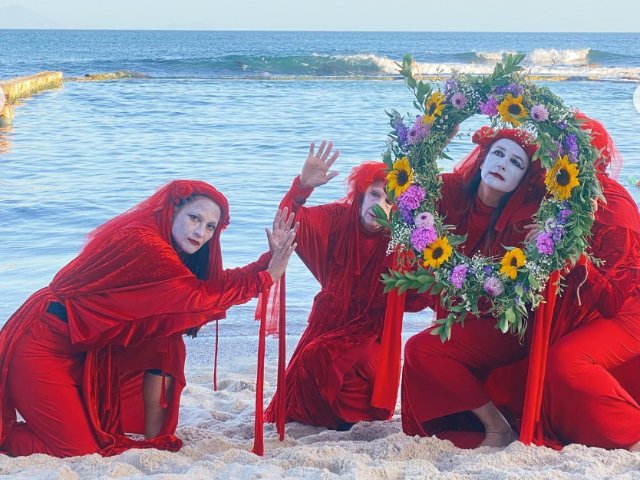[imagesource:instagram/extinctionrebellionsa]
Join Extinction Rebellion for a ceremony to honour the species we have lost to extinction, to share our collective grief, and to renew our commitment to fight for those that are left.
In Margaret Atwood’s short story “Worm Zero”, she presents a satirical vision of life after every form of worm has disappeared. In this world, “[T]he earthworms are now defunct, and that’s important—the soil is no longer circulating in the usual fashion. Worm dung is no longer extruded at the surface, wormholes no longer allow rain to penetrate. Valuable nutrients remain sealed in layers of subsoil. Formerly productive fields turn to granite. Crops become stunted and then won’t grow at all. Famine gets going” (The Tent).
In this wormless world, “civic order breaks down … and people start eating their cats and goldfish and dried ornamental sunflowers in their dining room floral arrangements” (The Tent). And it’s not just the disappearance of the earthworms that has material consequences. The absence of maggots results in “animal carcasses littering the … premises, gnawed on by crows and such, but not cleaned up neatly the way the maggots would once have done it” (The Tent).
Atwood presents the story as an impossible joke. However, she makes a harrowing, necessary point. Human life is inextricably entangled with nonhuman life. The health and stability of our society are dependent on the well-being of our environment and the lives of the creatures surrounding us.
This speculation on the consequences that arise from the disappearance of a single lifeform becomes more frightening when we consider the latest news around extinction. As research shows, we are facing the end of untold numbers of insects, plants, fungi, and animals. And with each species extinction, homo sapiens move one step closer to our end.
While this may sound hyperbolic, this past November saw the publication of a study sounding the alarm that the number of species at risk of extinction far exceeds previous estimates. Moreover, research shows that the rate of species extinction is 35 times higher thanks to human impact on the tree of life. While extinction is a necessary part of evolution and species pass in and out of existence across time, it is now undeniable that human activity has accelerated this process. Unlike the characters in “Worm Zero”, we are not facing the end of just one or two creatures, but the collapse of the whole web of life.
2023 alone has seen an extinction alert issued for the world’s tiniest marine mammal, the vaquita, of which only 10 individuals remain. An official red list of the UK’s endangered mosses, liverworts and hornworts was released this year, signalling the progress of biodiversity loss in a sphere of life that typically occupies a small portion of public consciousness. Australia saw frogs, crayfish, river fish, rats and marsupials added to their threatened species lists in anticipation of bushfire season, and in Dominica, the mountain chicken frog faces the “fastest track to extinction ever recorded”.
If we look to South Africa, activists have been fighting tooth and nail to protect endangered species like the Western Leopard Toad from further habitat destruction and consequent extinction and our African penguins remain critically endangered and on what appears to be an inexorable path to extinction.
Perhaps most devastating of all are the extinctions that were confirmed this past year, with the US Fish and Wildlife Service reclassifying 21 species from endangered to extinct, including the Bachman’s Warbler and the Little Mariana fruit bat.
With extinction surrounding us, you might ask what the point of a Lost Species Remembrance Day could be. What does it do for those species we have already lost, and those on the brink of extinction?

As Ursula Heise observes in her cultural study of species loss, Imagining Extinction, “public grief over what most societies have not normally considered worth mourning becomes an act of political resistance”. Lost Species Day is about holding space for all species – from the charismatic to the unspectacular; for remembering what we have lost so that we might cherish and protect those that remain.
It is as much a chance to mourn the decline of the dazzling Irrawaddy and Amazon river dolphins, Elephants and Orangutans as it is an opportunity to commemorate the fungi that disappear before we have a chance to catalogue them, the plants, amphibia, crustaceans, molluscs, fish, small mammals, bacteria and worms that do not make striking movement figureheads but who are crucial to our survival.
In mourning these beings, we make a political signal of our anger and our anguish. We communicate that the current scale of extinction is unbearable, and highlight the worth of the creatures disappearing at dangerous rates. We create a space for commiseration and mutual support through one frightening extinction event after another. Most importantly, as we mourn the nonhuman beings already lost or on the brink of extinction, we call for change to the systems that result in such horrifying loss of life – before homo sapiens become a lost species, too.
You are invited to join the climate activist organisation Extinction Rebellion for Remembrance Day for Lost Species.
Who? Extinction Rebellion Cape Town and you.
Where? St James Tidal Pool, Main Road, St James, Cape Town
When? Thursday 30 November 2023 18:00-19:00
The space will be open for people from different walks of life, ages, and backgrounds to share a short poem, song, or a thought about what the extinction of plants and animals means to them. The event is held on the beach and it is very relaxed but very moving. This gives you an idea of what it was like last year:
It can seem like quite a sad event, and in a way it is. However, if you are already carrying sadness about the destruction of the natural world, then it can be nourishing to be around others to take it as seriously, and it can remind us of the deep love we share for this beautiful world, and allow that to motivate us to keep on doing what we can to protect and save.
[source: Extinction Rebellion/Press Release for Lost Species Day]





